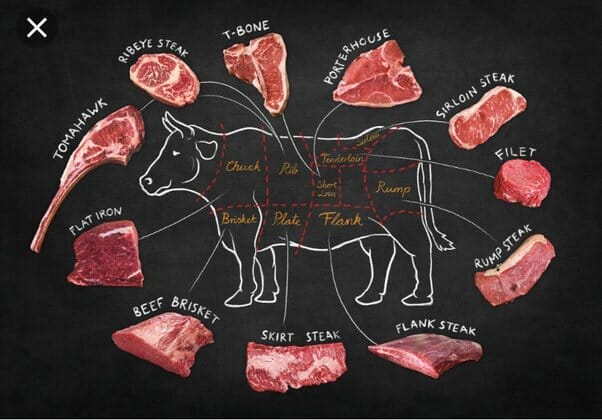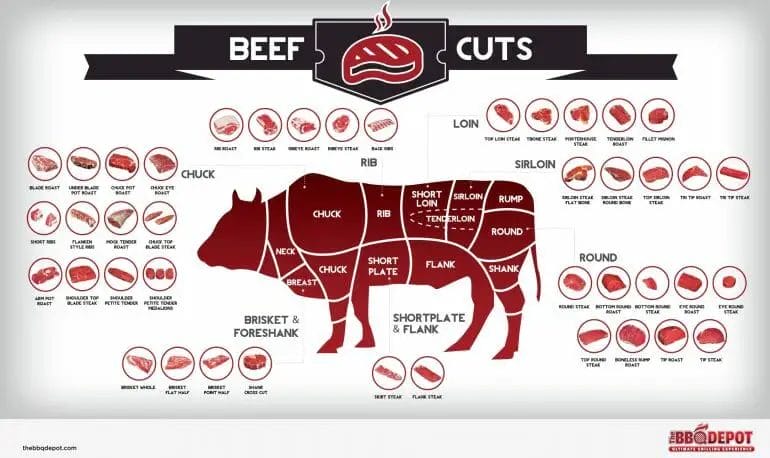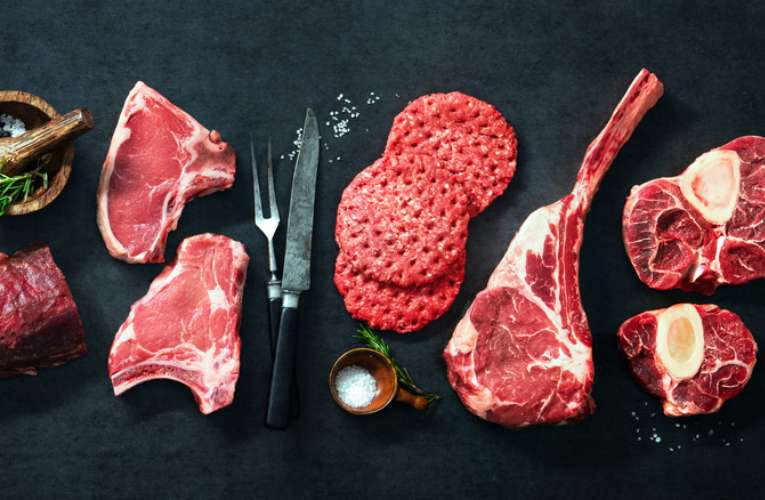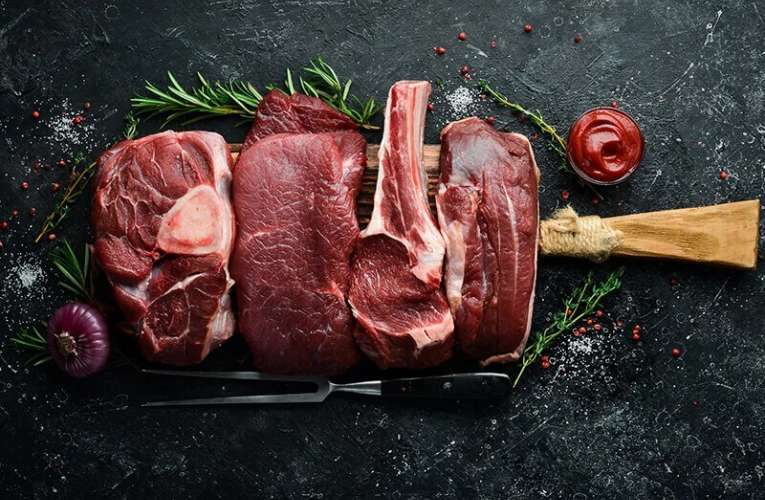Many people often wonder if beef and steak are the same thing. While both beef and steak come from cows, they are not exactly interchangeable terms.
Beef is the general term used to refer to the meat that comes from cows, whereas steak specifically refers to a cut of beef that is typically thick and tender.
In this article, we will further explore the differences between beef and steak, their various cuts, and how they are commonly cooked and enjoyed.

Understanding cuts of beef: A guide to the different cuts of beef commonly used for making steak
When it comes to enjoying a delicious steak, understanding the different cuts of beef is essential. Each cut has its own unique characteristics, flavor profiles, and cooking methods.
In this guide, we will explore the most common cuts of beef used for making steak, allowing you to make educated choices when selecting your next steak.
1. Ribeye
The ribeye is a popular cut of beef known for its excellent marbling and rich flavor. It is cut from the rib section of the cow and is highly desirable due to its tender and juicy texture. The ribeye is well-suited for grilling, pan-searing, and broiling.
2. Filet Mignon
Filet mignon is often considered the most tender cut of beef. It is extracted from the tenderloin section of the cow and has a melt-in-your-mouth texture.
Filet mignon is best enjoyed when cooked to medium-rare or medium, as overcooking can result in a loss of tenderness. It is commonly pan-seared or grilled.
3. New York Strip
The New York strip, also referred to as the strip steak or the sirloin strip, is a flavorful cut of beef that comes from the short loin section. It is known for its intense beefy flavor and firm texture. The New York strip is versatile and can be grilled, seared, or broiled to perfection.
4. T-Bone
The T-bone steak is a combination of two cuts of beef – the tenderloin and the New York strip – divided by a T-shaped bone. It offers the best of both worlds, with the tenderness of the filet mignon and the flavor of the New York strip. The T-bone is commonly grilled or broiled.
5. Sirloin
The sirloin steak comes from the rear back portion of the cow and is known for its robust flavor. It is a versatile cut that can be used for grilling, broiling, or pan-searing. While not as tender as some other cuts, the sirloin is often more affordable and delivers excellent flavor.
6. Porterhouse
The porterhouse steak is similar to the T-bone steak but has a larger portion of the tenderloin. It is considered one of the finest cuts of beef due to its tenderness and flavor. The porterhouse is best cooked on high heat, such as grilling or broiling, to bring out its full potential.
7. Flank
The flank steak is a lean and flavorful cut of beef prized for its versatility. It is cut from the abdominal muscles of the cow and has a pronounced beefy taste.
Flank steak is commonly used in dishes like fajitas, stir-fries, and as a filling for sandwiches. It should be cooked quickly over high heat and sliced against the grain for maximum tenderness.
8. Skirt
Skirt steak is another thin and flavorful cut of beef that comes from the diaphragm muscles. It has a deep, rich flavor and is commonly used in Mexican and Asian cuisines. Skirt steak is best cooked quickly over high heat and sliced against the grain to ensure tenderness.
9. Flat Iron
The flat iron steak is a relatively new cut that has gained popularity in recent years. It is taken from the shoulder region of the cow and is known for its tenderness and marbling. Flat iron steak is best cooked to medium-rare and is often grilled or pan-seared.
10. Chuck Eye
The chuck eye steak is a flavorful cut that comes from the shoulder area of the cow, near the ribeye. It is often referred to as the “poor man’s ribeye” due to its similar taste and texture at a more affordable price. The chuck eye steak is suitable for grilling, broiling, or pan-searing.
Now that you have a better understanding of the different cuts of beef commonly used for making steak, you can confidently choose the perfect cut for your next culinary masterpiece.
Whether you prefer a tender filet mignon or a juicy ribeye, each cut offers its own unique qualities that are sure to satisfy your taste buds.

Cooking Methods for Steak
If you want to enjoy a mouthwatering and tender steak, it’s essential to know the best cooking methods. Cooking steak is an art that requires precision and attention to detail.
In this section, we will explore various techniques to cook a delicious and juicy steak that will leave your taste buds craving for more.
1. Grilling
Grilling is one of the most popular methods to cook steak, as it enhances the flavor and adds a smoky char to the meat. Whether you prefer using a charcoal or gas grill, follow these steps for a perfectly grilled steak:
- Preheat your grill to high heat to achieve a nice sear.
- Season the steak with salt, pepper, and any desired seasonings.
- Place the steak on the hottest part of the grill and cook for a few minutes on each side, depending on the desired level of doneness. Use a meat thermometer to ensure accuracy.
- Let the steak rest for a few minutes before slicing to allow the juices to redistribute.
Grilling is ideal for thicker cuts of steak like ribeye, striploin, or T-bone.
2. Pan-Searing
If grilling is not an option, pan-searing is a fantastic alternative that can still deliver a delicious seared steak. Here’s how to pan-sear a steak:
- Choose a heavy-bottomed skillet or cast-iron pan for even heat distribution.
- Heat the skillet over high heat and add a high smoke point oil like vegetable or canola oil.
- Season the steak generously with salt, pepper, and other desired seasonings.
- Place the steak in the hot skillet and sear for a few minutes on each side to form a golden crust.
- Lower the heat to medium and continue cooking the steak until it reaches the desired level of doneness.
- Let the steak rest for a few minutes before slicing to retain its juices.
Pan-searing works well for thinner cuts like filet mignon, sirloin, or skirt steak.
3. Sous Vide
Sous vide is a precise and foolproof method to cook steak to perfection. It involves vacuum-sealing the steak in a plastic bag and cooking it in a temperature-controlled water bath. Here’s how to cook steak using sous vide:
- Season the steak with salt, pepper, and any desired seasonings.
- Place the steak in a vacuum-sealed bag or a resealable plastic bag and remove any excess air.
- Preheat a sous vide immersion circulator to the desired temperature for your preferred level of doneness.
- Submerge the bagged steak into the water bath and cook for the recommended time.
- After cooking, remove the steak from the bag and pat it dry with a paper towel.
- Sear the steak in a hot skillet or grill for a few seconds on each side to develop a crust.
Sous vide cooking ensures precise temperature control and results in a tender and evenly cooked steak.
4. Broiling
Broiling is a quick and convenient method to cook steak in the oven. It provides a charred and caramelized exterior while keeping the center juicy. Follow these steps for broiling a steak:
- Preheat your oven on the broil setting.
- Season the steak with salt, pepper, and any desired seasonings.
- Place the steak on a broiler pan or a wire rack set on top of a baking sheet.
- Position the steak on the top rack of the oven, a few inches away from the broiler element.
- Cook the steak for a few minutes on each side, depending on the desired level of doneness.
- Remove the steak from the oven and let it rest for a few minutes before serving.
Broiling creates a delicious crust on the steak’s surface and is perfect for cuts like flank steak or flat iron steak.
5. Reverse Searing
Reverse searing is a unique method that involves slow-cooking the steak in the oven first,

Nutritional benefits of beef
Beef is a popular source of protein and essential nutrients, and it offers numerous health benefits. In this section, we will explore the nutritional value of beef and discuss its positive impact on overall health.
Protein
Beef is a rich source of high-quality protein, which is essential for the growth and repair of tissues in the body. Protein plays a crucial role in building muscles, bones, cartilage, and skin. It also helps in the production of enzymes, hormones, and antibodies.
When consumed, the protein in beef is broken down into amino acids, which are then used by the body to carry out various functions. Including beef in your diet ensures that you meet your daily protein requirements and supports optimal body functioning.
Vitamins and Minerals
Beef is a good source of various vitamins and minerals that are necessary for overall health. It contains B-vitamins, including vitamin B12, which is primarily found in animal products. Vitamin B12 is essential for the production of red blood cells and the proper functioning of the nervous system.
Additionally, beef is a rich source of minerals such as iron, zinc, selenium, and phosphorus. Iron is crucial for the production of hemoglobin, which carries oxygen to cells and tissues. Zinc supports immune function and wound healing, while selenium acts as an antioxidant, protecting cells from damage.
Healthy Fats
Contrary to popular belief, beef also contains healthy fats. The fat content in beef varies depending on the cut and quality. Lean cuts of beef, such as sirloin or tenderloin, are lower in fat and calories.
Beef contains both monounsaturated and polyunsaturated fats, which are known to have several health benefits. These fats help reduce bad cholesterol levels, lower the risk of heart disease, and provide a source of energy for the body.
Conjugated Linoleic Acid (CLA)
Beef is one of the richest dietary sources of conjugated linoleic acid (CLA). CLA is a type of fatty acid that has been associated with various health benefits. Studies suggest that CLA may help reduce body fat, improve immune function, and have anti-inflammatory properties.
Amino Acids
Beef contains a wide range of essential and non-essential amino acids. These amino acids are the building blocks of proteins and play a vital role in numerous physiological processes in the body.
One notable amino acid found in beef is creatine. Creatine is involved in energy production and is primarily stored in the muscles. Supplementing with creatine has been shown to improve exercise performance and muscle strength.

Popular Steak Recipes: A Collection of Mouth-watering Steak Recipes to Try at Home
Steak is a classic dish that is loved by many for its rich flavor and tender texture. Whether you prefer your steak rare, medium, or well-done, there are countless ways to prepare it to perfection.
In this section, we will explore a collection of popular steak recipes that will tantalize your taste buds and leave you craving for more.
1. Grilled Ribeye Steak
One of the most iconic steak recipes is the grilled ribeye steak. This juicy and flavorful cut of meat is perfect for grilling, as it develops a delicious charred exterior while remaining tender and moist on the inside.
To make this recipe, season the ribeye steak with salt, pepper, and your choice of herbs and spices. Then, preheat your grill to high heat and cook the steak for about 4-5 minutes per side for medium-rare. Let it rest for a few minutes before slicing and serving.
2. Pan-Seared Filet Mignon
For an elegant and indulgent steak experience, try pan-seared filet mignon. This tender and buttery cut of meat is best cooked in a hot skillet to achieve a beautiful crust on the outside while keeping the center melt-in-your-mouth tender.
Start by seasoning the filet mignon with salt and pepper. Then, heat a skillet with oil over high heat and sear the steak for about 3-4 minutes per side.
Finish it off in the oven at 400°F for a few minutes to reach the desired doneness. Serve it with a side of creamy mashed potatoes or roasted vegetables.
3. Marinated Skirt Steak Tacos
If you’re in the mood for something a little more casual and flavorful, try making marinated skirt steak tacos. Skirt steak is a thin and juicy cut of meat that is perfect for grilling or pan-searing. To make this recipe, prepare a marinade using lime juice, soy sauce, garlic, and your favorite spices.
Marinate the skirt steak for at least 30 minutes or overnight for maximum flavor. Cook the steak on a hot grill or in a skillet for about 3-4 minutes per side. Slice it thinly and serve it in warm tortillas with your favorite toppings such as salsa, avocado, and cilantro.
4. Garlic Butter Sirloin Steak
For a steak recipe that is bursting with flavor, try garlic butter sirloin steak. This recipe combines the rich flavors of garlic, butter, and herbs to create a mouth-watering steak that is perfect for any occasion. Start by seasoning the sirloin steak with salt, pepper, and garlic powder.
Heat a skillet with butter over medium-high heat and cook the steak for about 4-5 minutes per side for medium-rare. Add minced garlic and fresh herbs such as thyme or rosemary to the skillet and baste the steak with the melted butter mixture. Let it rest for a few minutes before slicing and serving.
5. Asian-Style Flank Steak Stir-Fry
If you’re looking to add an Asian twist to your steak recipe, try making an Asian-style flank steak stir-fry. Flank steak is a lean and flavorful cut of meat that is perfect for stir-frying.
Start by marinating the flank steak in a mixture of soy sauce, ginger, garlic, and sesame oil for about 30 minutes. Heat a wok or large skillet over high heat and stir-fry the steak with vegetables such as bell peppers, onions, and broccoli. Serve it over steamed rice or noodles for a satisfying and delicious meal.

FAQs
Is beef and steak the same thing?
No, beef and steak are not the same thing. Beef is the meat obtained from cattle, while steak is a specific cut of beef that is taken from the muscle of the animal. Steak is known for its tenderness and is often grilled or pan-seared for consumption.
Conclusion
In conclusion, beef and steak are not the same thing. Beef refers to the meat that comes from a cow, while steak specifically refers to a cut of beef that is typically tender and flavorful. Although all steaks are made from beef, not all beef cuts can be considered steak.
Steak is known for its tenderness, juiciness, and rich flavor, making it a popular choice for meat lovers. Whether you’re grilling a ribeye, enjoying a tenderloin, or savoring a T-bone, steak offers a delightful dining experience that showcases the best qualities of beef.
When it comes to cooking beef, understanding the different cuts and their characteristics can help you achieve the desired taste and texture.
So, whether you prefer a well-marbled ribeye, a lean sirloin, or a melt-in-your-mouth filet mignon, knowing the nuances between beef and steak will empower you to make informed decisions while exploring the diverse world of culinary delights that beef has to offer.

